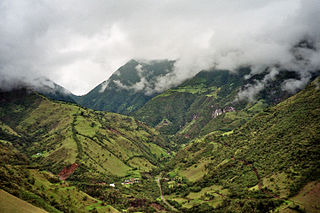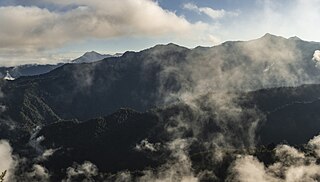
The Republic of Colombia is situated largely in the north-west of South America, with some territories falling within the boundaries of Central America. It is bordered to the north-west by Panama; to the east by Brazil and Venezuela; to the south by Ecuador and Peru; and it shares maritime limits with Costa Rica, Nicaragua, Honduras, Jamaica, the Dominican Republic, and Haiti.

Ecuador is a country in western South America, bordering the Pacific Ocean at the Equator, for which the country is named. Ecuador encompasses a wide range of natural formations and climates, from the desert-like southern coast to the snowcapped peaks of the Andes mountain range to the plains of the Amazon Basin. Cotopaxi in Ecuador is one of the world's highest active volcanos. It also has a large series of rivers that follow the southern border and spill into the northwest area of Peru.
A cordillera is an extensive chain and/or network system of mountain ranges, such as those in the west coast of the Americas. The term is borrowed from Spanish, where the word comes from cordilla, a diminutive of cuerda ('rope').

Mejía is a canton in the province of Pichincha in northern Ecuador. It is named after Ecuadorian political figure José Mejía Lequerica. The canton includes a volcano in the Central Cordillera of the Ecuadorian Andes called Rumiñahui. The seat of the canton is called Machachi.

San Miguel de los Bancos, or simply Los Bancos, is a canton in the province of Pichincha, Ecuador. The long name of the town refers to dedication of the area to the archangel Michael. Local tradition attributes the "Los Bancos" part of the name to the use of tree trunks as benches at the junction of the through road from Quito to Esmeraldas with the road into the Rio Blanco valley.
Cordillera Occidental is Spanish for "Western mountain". It may refer to:

The Cordillera Occidental is the lowest in elevation of the three branches of the Colombian Andes. The average altitude is 2,000 m (6,600 ft) and the highest peak is Cerro Tatamá at 4,100 m (13,500 ft). The range extends from south to north dividing from the Colombian Massif in Nariño Department, passes north through Cauca, Valle del Cauca, Risaralda, Chocó, and Caldas Departments to the Paramillo Massif in Antioquia and Córdoba Departments. The cordillera is paralleled on the east by the Cauca river. From this massif the range divides further to form the Serranías de Ayapel, San Jerónimo and Abibe. Only to recede into the Caribbean plain and the Sinú River valley.

The Cordillera Occidental or Western Cordillera of Bolivia is part of the Andes, a mountain range characterized by volcanic activity, making up the natural border with Chile and starting in the north with Juqhuri and ending in the south at the Licancabur volcano, which is on the southern limit of Bolivia with Chile. The border goes through the innominated point located at two-thirds of elevation of Licancabur's northeastern slope at the southwestermost point of Bolivia at 22° 49' 41" south and 67° 52' 35" west. The climate of the region is cold and inadequate for animal and plant life. Its main feature is its ground, in which are large quantities of metallic minerals including gold, silver, copper, and others.The range consists of three sections:

The Cordillera Central is a Bolivian mountain range that divides the three river basins in the country and also has the second highest peaks in Bolivia. It is rich in minerals and starts in the north with Chawpi Urqu and the three Palumanis that were in the south up to Zapaleri, forming a border with Chile and Argentina. The Cordillera Central is divided into three sections:

The Cordillera Occidental range is one of two main mountain ranges in the Andes in Ecuador, the other being the Cordillera Central. It spans the whole country from north to south. The highest peak of the Cordillera Occidental is Chimborazo.
Microryzomys altissimus, also known as the Páramo colilargo or highland small rice rat, is a species of rodent in the genus Microryzomys of family Cricetidae. It is found in Colombia, Ecuador, and Peru, but the Colombian segment may be a separate species.
Microryzomys is a genus of rodent in the tribe Oryzomyini of family Cricetidae. It is closely related to Oreoryzomys, Oligoryzomys, and Neacomys. It contains two species, both restricted to the Andes: M. altissimus and M. minutus.
Microryzomys minutus, also known as the montane colilargo or the forest small rice rat, is a species of rodent in the genus Microryzomys of family Cricetidae. It is found in Bolivia, Colombia, Ecuador, Peru, and Venezuela, but these populations may represent more than one species.

Pristimantis buckleyi is a species of frog in the family Strabomantidae. It is found on the Andes of Colombia and Ecuador. Specifically, it occurs on the both flanks of the Cordillera Central and on the eastern flank of the Cordillera Occidental in Colombia, and on the Cordillera Real in Ecuador south Cayambe, at elevations of 2,500–3,700 m (8,200–12,100 ft) asl.

Gastrotheca guentheri is a species of frog in the family Hemiphractidae. It is found in the Andes of Colombia and Ecuador. Gastrotheca guentheri is the only known frog with true teeth in both of its jaws, as indicated by the name of the genus it originally typified, Amphignathodon, described by George Albert Boulenger in 1882.

Geology of Colombia refers to the geological composition of the Republic of Colombia that determines its geography. Most of the emerged territory of Colombia covers vast areas within the South American plate, whereas much submerged territory lies within the Caribbean plate and the Nazca plate.
The wandering Oldfield mouse, also called the wandering thomasomys, is a species of rodent in the family Cricetidae. It has been found in both the Cordillera Oriental and Cordillera Occidental of the Andes in central and north central Ecuador, at elevations from 2400 to 3600 m. It has terrestrial habits, and has been found in cloud forest and areas of secondary vegetation. It was formerly considered a subspecies of T. cinereiventer.

The Bellavista Cloud Forest Reserve is a 2,000-acre (8.1 km2) certified conservation area on the North-Western slopes of the Andean mountain range and is located 52 km from the Ecuadorian capital city of Quito. The lodge itself comprises guest rooms, 10 km of walking trails and the four storey geodesic dome, which contains a restaurant, viewing platforms and further accommodation. The Reserve was first established in 1991 by a British/Colombian couple. The area won the Audubon Christmas Bird Count for the Americas in 2006, 2007, and 2008.
Western Cordilleras can refer to

The Eastern Cordillera Real montane forests (NT0121) is an ecoregion in the eastern range of the Andes of southern Colombia, Ecuador and northern Peru. The ecoregion covers the eastern slopes of the Andes, and includes montane forest that rises from the Amazonian rain forest, with cloud forest and elfin forest at higher elevations. It is rich in species, including many endemics. It is threatened by logging and conversion for pasturage and subsistence agriculture.













